Engagement Ring - In Progress
Setting
Stone
Purchase any Engagement Ring and receive a $250 Gift Card for your Wedding Band. Ends soon.
Deepen the well of love in the world.
We guarantee that every single purchase directly impacts one person's life by giving them access to clean water.
The diamond on the left is $13,150. The one on the right is priced at $4,560. Same size. Same sparkle. They’re both natural diamonds. Want to know how I did it? We’ll let you in on the 4Cs secrets below…

Here’s the truth: You don’t need a flawless diamond. And you don’t need a colorless diamond. In fact, you can use each of a diamond’s 4Cs (color, cut, clarity, and carat weight) to save a significant amount of money. All you need to know are the little tips and tricks jewelers use to get the best diamond price.
Want to join our inner circle? Here are my jeweler’s secrets for maximizing value when buying a diamond:
Choose G or H color instead of colorless. The color of a diamond is the whiteness or color tint of the stone. It is one of its “4Cs” – the way a diamond is graded. The diamond grading color scale goes from D to Z. The more “colorless” a diamond is, the closer to D on that scale it will be. Likewise, the more color a diamond shows (in natural diamonds they lean towards champagne, in lab diamonds they can appear champagne or even blue), the closer to Z it will be.
In most circumstances, the best value in diamond color is G or H. This is because they are “white,” without commanding the pricing premiums of a “colorless” stone. In fact, G color is only one step down from colorless, and shows no visual difference. So, to get the best diamond price on a great looking stone, choosing G or H is your best bet. Click here to learn more about diamond grading for color, and also how diamond shape and ring choice may affect what color diamond you want!

A GIA color diagram. (Photo by: GIA)
Choose an eye clean VS2-SI1 instead of VVS+ (you can’t tell the difference without a microscope). Another major 4C diamond grade is the clarity of your stone. This is how “crystal clear” the diamond is on the clarity ratings chart. Diamonds have small marks (called “inclusions”) on the inside of the stone. They are like birthmarks! The diamond grading clarity scale goes from FL (flawless) to I3 (included). So, the fewer inclusions a stone has, the more “flawless” it is.
In most circumstances, the best values in diamond clarity are VS2 and SI1. VS2 and SI1 clarity diamonds are typically “eye clean.” So, the inclusions cannot be seen with the naked eye, but are better priced than more flawless diamonds. Click here to learn more about diamond grading for clarity, and also how diamond shape affects the best clarity choice for your ring.
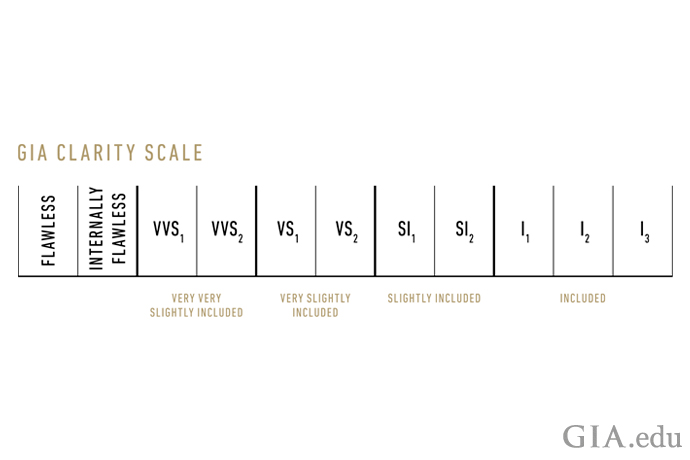
A GIA Clarity scale. (Photo by: GIA)
Choose a “light” carat weight – they are priced better without any difference in size. Carat weight is the third of the 4Cs and means how heavy a diamond is. As a result, carat weight does not always equal face up size. It only relates to weight. One “carat” is equal to 200 milligrams. Carat is abbreviated “ct.” Like pennies in a dollar, there are 100 “points” in a carat. The diamond grading scale for carat weight uses both carats and points. A carat weight of 1.56ct is pronounced “one point fifty six carats.”
Listen in! Your diamond’s measurements will depend on how deep or shallow it is cut. For example, a 1.00ct round brilliant diamond could be 6.2mm, 6.5mm, or 6.7mm in diameter.
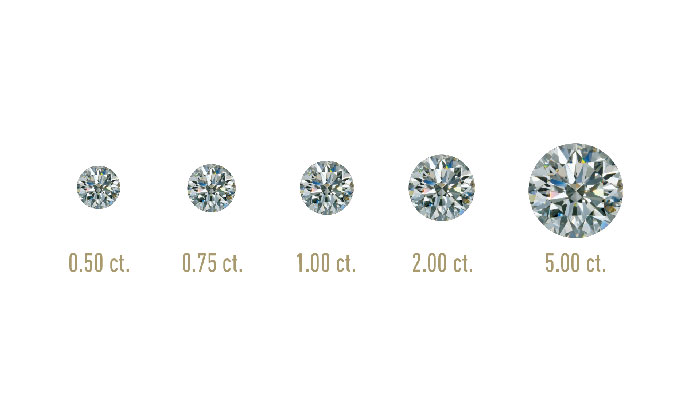
A GIA Carat weight scale. (Photo by: GIA)
Merchants in the diamond industry price diamonds “per carat,” kind of like how meat and cheese are priced “per pound” at the deli counter. However, instead of the “per pound” price staying the same, per carat pricing increases at each and every size category. But, you can use this to your advantage!
So, you get the best diamond price by choosing a carat weight that falls just below major size categories. That is to say, a 0.98ct may be better priced than a 1.01ct, despite being the same measurements. This is because the 0.98ct may be priced at “below a full carat” pricing, whereas the 1.01ct is priced as a full carat. Diamond experts call these diamonds which weigh “just below” a major size category “lights.”
For example:
I always look for great deals in light carat weight diamonds!
Always choose Excellent cut – you waste money on wasted sparkle. A diamond’s cut is both its shape (round, princess, heart), as well as how well the angles of the diamond reflect light. Many diamond experts believe Cut is the most important of the 4Cs in choosing a diamond. This is because cut determines how sparkly your diamond is! The GIA diamond grading scale for cut begins at Excellent and ends at Poor:
The best value in diamond cut is Excellent, because you do not want to waste money on a diamond that does not give the best sparkle!
Gemologists call the little flat cuts on a diamond “facets.” Light reflects off facets because diamonds are crystals (just like those prisms you saw at the science museum when you were a child). Excellent cut diamonds are stones in which the facets are arranged in the best pattern, and at the best angles, to maximize light return and sparkle.
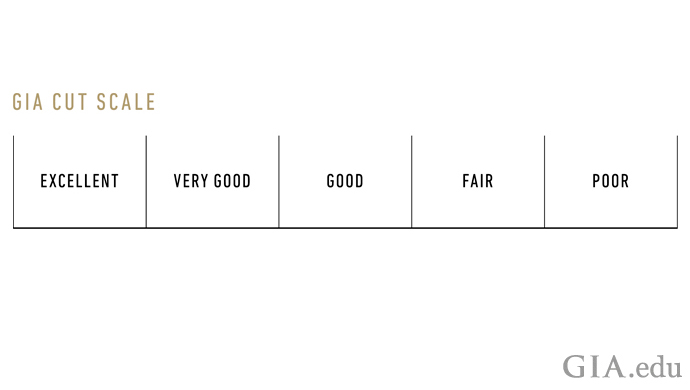
GIA Cut scale. (Photo by: GIA)
So now you know the 4Cs of color, cut, clarity, and carat weight. But what is it going to cost you? And where does that money go? Diamonds are priced based upon rarity. The higher up on each of the quality scales you go, the rarer the diamond is, and the more expensive. So, finding the sweet spot on each scale – where you can’t see the difference with your naked eye – is the best way to save money.
To wrap things up, let’s recap the sweet spots so you can see how I saved so much with those diamonds at the top of the post. Because saving money without sacrificing quality is the best.
Here they are again:

LEFT: 1.00ct, D/IF, 6.43 x 6.46, $13,154 | RIGHT: 0.96ct, G/SI1, 6.39 x 6.42, $4,560
A bright white G color, eye-clean SI1 clarity, light carat 0.96ct is literally a third of the price of the colorless, flawless, full carat stone without any visual difference! Both of these stones are Excellent cut – so they will both be blindingly brilliant. Which do you think is the better deal?
Lab created diamonds are visually identical to natural diamonds – one is just made in a lab! The technological advancements in lab created diamonds are truly remarkable. Lab stones are now created to exacting standards and can be colorless, flawless, and come in incredible sizes (however, you now know to look at G/VS)! And even more amazing – they are a fraction of the cost of natural stones. Imagine saving another fifty percent on the values you’ve just learned to maximize!
Where do the profits go from your diamond purchase? If you’re reading this, you’re one of the growing majority of savvy shoppers who see that buying a diamond online instead of in-store can result in significant savings. So you’re already ahead of the game. But which online diamond seller to choose?
At Do Amore – when you choose a diamond, you help build a well for a community in need. Without any cost passed to you. Compare us and see! Where else can buying a diamond make such an impact?! Learn more about our commitment to delivering clean water to developing countries here.

A community celebrating the drilling rig hitting water in Chinkhwamba 1 Village.
I’m happy to! It is a ton to remember. But we’ll help you through it. Our gemologist (me!) hand-selects great diamonds everyday! Feel free to email me with questions (my name is Corinne), a picture, or even a dream and a budget, and I’ll find you the perfect engagement ring.
Verifiably Ethical & Sustainable
Guaranteed 1:1 Impact
Personalized 1:1 Customer Service
handcrafted & american-made
you before us, always
Diamonds, Gemstones, & Metals
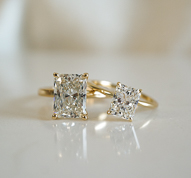
Every piece of Do Amore jewelry begins by not hurting the world. All our natural diamonds are either ethically sourced in Canada, recycled to eliminate additional demand, or accompanied by a blockchain ledger showing every hand your diamond passed through, proving your stone is truly conflict-free.
We also offer sustainable lab-created stones and guarantee all precious metals are recycled to eliminate the environmental impact of mining. Since March 2022, we carry absolutely no Russian diamonds and continue to urge the industry to follow suit.
Clean Water
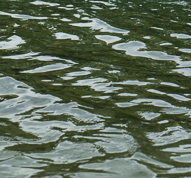
We desire to deepen the well of love in the world. We guarantee that every single purchase—whether engagement ring, wedding band, or piece of jewelry—directly impacts one person’s life by giving them access to clean water.
We do this by directly matching jewelry purchases to people in communities to ensure our funding has a one-to-one impact. We also show you the exact GPS coordinates and a photo of the water well your ring or piece of jewelry helped fund.
Customer Service
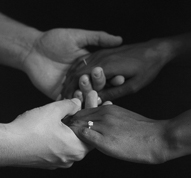
As a small, 100% founder- and employee-owned team, one-to-one encounters are at the heart of our values. Whichever way you want support throughout your engagement ring or jewelry purchase process, our team is here to accommodate you.
From high-touch to hands-off, video calls to text messages, you have our dedicated, responsive team on your side from the moment you start your search, to the day your well is built, to the time we meet again.
Engagement Rings, Bands, & Jewelry
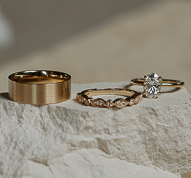
Every Do Amore design, whether one of our own or unique to you, is beautifully handcrafted in America and made specifically for you. Each ring is made to order, every time.
From classic to custom, you have the option to select from dozens of gorgeous settings or work with our design team to create something entirely bespoke. Plus, you are always covered for free inspections, polishing, cleaning, stone tightening, rhodium-plating, and resizing for life.
Our Promise
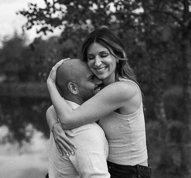
We care about what matters most to you, not what’s easiest for us. If it’s a minor change to a setting or arriving at a completely custom design, we work to ensure you get precisely what you love.
From statement-making to understated, we have options at any price point. Plus, you always have our team on your side searching to bring you every stone within your specifications. We also offer 30-day returns and a limited lifetime warranty to cover you in the rare event of a manufacturing defect.